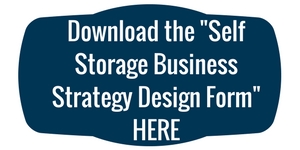Welcome to the fourth and final episode of the series “The Complete Guide to Creating Your Self Storage Business Strategy.”
We have been talking about the three aspects that determine our success in achieving any vision, or goal:
1). Mental state.
2). The stories we tell ourselves, and,
3). The strategies.
These are listed in the order of importance. As humans, though, we gravitate immediately and almost without exception to number 3. I do it as a teacher because it is the easiest thing to do. We do it as students because it is the easiest and most satisfying for the mind to focus on.
If you haven’t seen or read the first three episodes in this series, stop now, click here, and read or watch.
Two weeks ago, we went deep into “State.” Ways to create mental states that support our needs for self storage success. Last week we learned a process to uncover disempowering stories we have created for ourselves.
After reading comments and answering emails, there are a few things I want to expand on:
1. Nothing is wrong or off because we have created stories. We all do. It is how we have survived as a species.
2. There is great opportunity in discovering these stories. Uncovering one and owning it creates a pathway for creating something new and powerful in our lives. It’s like there is now a door in what was before a blank wall. You now have the key to a door that can take your business and life to the next level.
3. Altering mental states and uncovering stories is a lifetime endeavor. I use these processes at least a few times a week if not daily. I’m always looking for opportunities to up the game.
What I have discovered while working with people is that when they are jammed up, not achieving what they want for their business, it’s usually a function of state or story. It’s not a strategy that’s blocking them.
However, a strategy is very, very important, and let’s dive into it here.
What I want to do this week is talk about the areas of focus that create a powerful self storage business strategy. I also have a free worksheet you can download below.
In this limited space I can’t take you in depth through all the steps, but we will cover what they are.
I have found that if someone addresses the following business areas in depth there is clear direction. This allows every opportunity as well as every current facility in production to show up very differently than before. You have a clear direction and vision to fulfill on.
Remember, if you don’t know where you are going, all roads lead to nowhere.
Stop looking for “good deals.” Start looking for opportunities that fulfill on a larger strategy, a larger vision of what’s possible for your self storage business.
Areas of Focus:
WHY:
Why do you want to start or grow your self storage business. Really, why?
Most people say it’s the money. Consider for a moment that it’s not the money. It’s never the money. Let me say that again, it’s never the money.
It’s what you think the money will provide. Go deeper. What is the reason you are willing to go through everything it will take to create this business? What will it provide?
Here are some examples:
- Financial Independence so my family never has to worry.
- A business I can pass on to future generations.
- Retirement so my wife or husband and family does not have to worry.
- Ability to be my own boss and live a life I created.
- Have the fulfillment of building something for me rather than another person or company.
There are many reason, but it is never the money. It is what the money provides.
This is critical to figure out. If you don’t have a compelling “Why” to pull you over the rough patches, you will eventually run into roadblocks and dead ends. The “Why” is what will keep you moving when the going gets tough.
YOUR STRENGTHS/WEAKNESSES:
Every one of us has things we excel in and things we are not so good at. If I have learned one thing, it is not to try to force myself, a child, an employee, or anyone to have to be accountable for things they are not naturally good at.
For example, I am good at marketing, speaking, and putting deals together. I am not naturally good at handiwork, using my hands, building things. You get the picture. So when we get to the construction phase of our business, I need help there.
I can hire the help, vendor the help, or have a partner who has the skills I don’t have (I do all three).
If you know all the phases of the business strategy, you can determine where you are weak. You then determine if you are going to hire someone to cover for where you are week, vendor it out, or get a partner.
I will use myself as an example for this article so you can get the picture. My experience is many people interested in this business are almost the opposite of me (which is fine). They’re good with their hands and have experience building things and/or construction. They may be weak in marketing, deal finding and analysis, etc.
Not a problem. Get a partner or hire it out. You can try to learn it, but my coaching is, if it doesn’t come naturally, if it seems like an uphill push, if you don’t enjoy it, let someone who is naturally good at it and likes to do it take over that piece.
So here are the general areas in the business you need to determine your strengths and weaknesses:
- Finding the opportunities.
- Analyzing opportunities.
- Negotiating the deals and putting them under contract.
- Construction experience for new construction and expansion deals. It’s always good to have someone with this experience, even for ongoing maintenance. But at certain times in the industry business cycle, this is very important.
- Cash or equity.
- Financing. The ability to get a loan.
- Management of the facility.
- Managing people.
Where are you strong and where do you need support?
How do you want to get that support in the different areas?
Let me use myself as an example again:
- I am a commercial realtor so I can find the deals.
- I can analysis the deals (using the Storage World Analyzer [TEST: http://storageworldanalyzer.com/] (shameless plug)
- I can negotiate the deals, but sometime rely on my lawyer for help.
- I am not good at construction, so we vendor out construction management. I know the phases and what we want, so I don’t hire a general contractor. But I vendor out this weakness.
- I didn’t, and don’t have a lot of liquid cash, so I have partners who do.
- I have partners who have the financial strength for the size loans we need for our business strategy.
- I am not goods at facility management. If I did it I also would not have enough time to grow the company so I have a partner who runs operations and management.
- I am not naturally good at managing people, but I do it to some degree. However, my Operations Partner is generally accountable for this.
These are my personal strengths and weaknesses and how I chose to deal with them.
You can see, I have working partners and investment partners. So I have to share ownership in the self storage business.
To achieve what I am after personally (and my partners are aligned with the vision), I have to acquire many properties.
This may or may not be what works for your vision.
WHO:
Do the exercise above. Now determine if you want a partner, employee or vendor for each area.
Its not critical at this stage for you to put names next to each area where you are going to need help, but begin thinking about it.
WHAT:
Now, at this point you are beginning to see how big, or how many, facilities you are going to need.
Get present to your “Why.”
Get present to how many partners you think you’re going to need, if any.
Now, how many self storage facilities do you think you will need?
Do you see larger, more “institutional” grade projects (i.e. 50,000 sq. ft. or more with gate access, retail sales, managers running the facility etc.). Do you see smaller facilities run lean and mean?
Which would be a better match given your “Why” and “Who” and “What” you are beginning to see.
WHERE:
Where do you see these self storage facilities?
In you home town, you state, certain regions of the country?
Why there?
You need to know this so you can articulate your strategy and vision.
Example: We are focused on states in the southeast and southwest because we see people migrating there over the next ten years. This migration, coupled with population growth in these states, creates demand for self storage.
(This is our strategy. I’m not saying it’s correct or you should use it. It gives me the ability to speak from a power position to say it when I’m talking to potential investors and lenders. I know it inside and out. I can say it in my sleep).
EQUITY:
How much money are you working with?
In many ways, this determines a lot. At least it did for me.
I work with lot of people who want to own a larger portfolio, but have limited cash. Therefore, they are going to have to raise money from investors and use that money to create the equity in the projects.
For using that money, you have to give up something. Usually it’s ownership. This is not the time or place to discuss how this may look, or the different options. (There are posts on the blog on this topic and more to come soon!)
Back to the question, how much money do you have to work with?
This will determine how big, how many facilities, etc. unless you have partners or investors.
I made the decision that instead of owning two or three facilities (where I ran out of capital to invest), I would rather own a smaller percentage of a larger portfolio.
What are you going to do with the money you have or don’t have?
DEBT:
Unless you have a lot of cash (equity), you are most likely going to have to get a loan.
How much of a loan do you qualify for?
If you can’t qualify for a loan, you are most likely going to have to have a partner who will.
Who will that be?
Why that person and what are you going to give them in exchange for signing on a loan with a bank?
It is not critical at this moment that you know who, but it is appropriate now to determine if you are going to need more financial strength.
If yes, then most likely, they are going to want ownership, cash flow, and upside potential in exchange for taking on the risk for you.
If you are going to have a partner signing on the debt, do you want a passive partner or an active partner? Do you need help with any of the aspects of the business you’ve determined from the work above?
If so, could this partner also be providing skills where you need support?
In my case, the answer was “yes”. One of the guarantors signing on the loans also runs the operations of the business.
How can you begin to envision your organization now?
Now you have the beginning of a great business strategy. This is not a “Business Plan,” but I have never had anyone ever ask for a business plan.
This is the start of a strategy, that will ultimately be part of the vision you have for your self storage business.
Then everything begins to fall in place. For example, if you need to pay your investors 10% return, looking at a deal becomes very easy. What do I have to pay to get the return I need?
Does this facility look like what my strategy calls for?
Is it located where I need it to be?
You stop chasing deals and start putting facilities into service that forward the strategy you created.
Life gets simple and simple is good.
Do the work and transform your business.
And remember the work includes all three elements: your Mental State, your Stories, and your Strategy.
Once last thing – have fun. It is a blast creating this from nothing. Enjoy it. Ultimately, who you become as you create your self storage company is where the adventure is anyway.






Thank you, for me to see this in a compartmental, easy to understand story type format — allows me to create and generate what I’m up to with my SSBiz product, team, submarket, and confidence that this is who, what, where, when, and how I create my SSBiz-Portfolio.